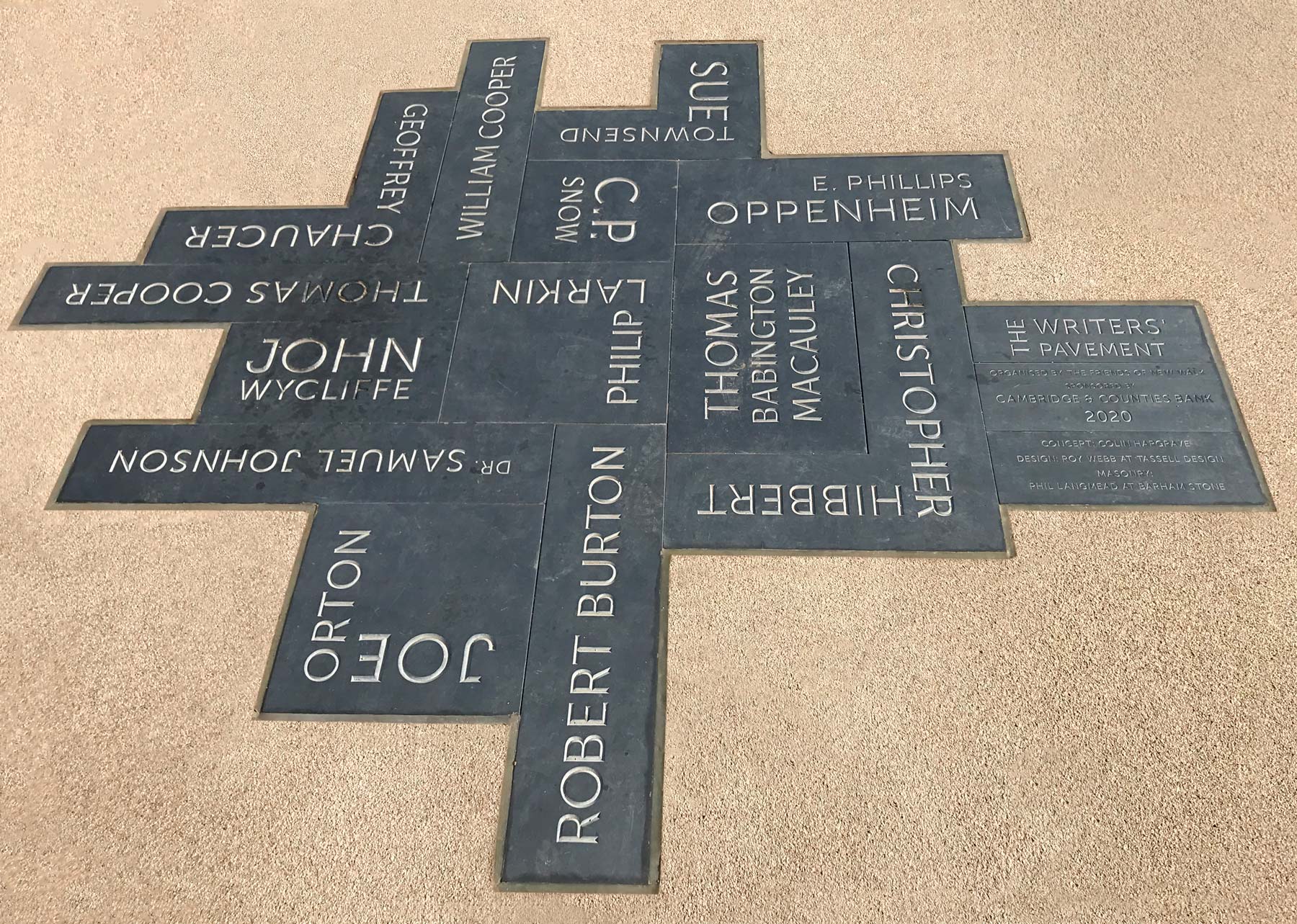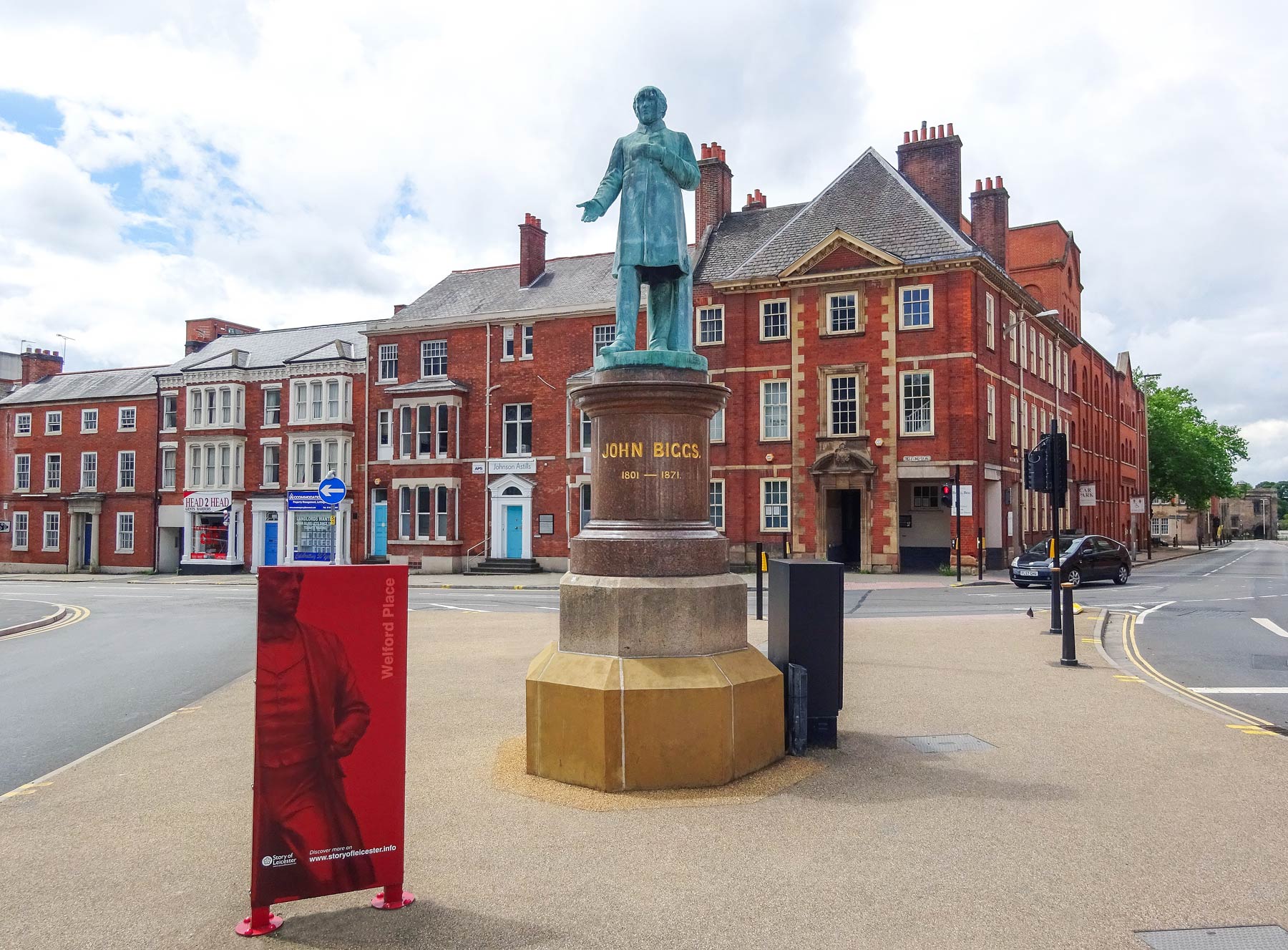Art and sculpture
The New Walk Heritage Park
In 2003 the Friends resolved that as part of their efforts they would launch a project to enhance New Walk with a series of sculptures, plaques and other commemorations of famous people connected with the City and the County. The idea was to improve the look of New Walk, create points of interest on it for pedestrians, act as a linear history lesson for schoolchildren and promote tourism.
The Friends anticipated that this could take up to 30 or 40 years because of the obvious difficulties of such a project, particularly the cost. In 2003 there were only two statues on New Walk, those of Robert Hall and John Biggs. However, the past 15 years have seen, in chronological order, the erection of The Clicker, The Clothier and Concerto. In 2020, the Friends completed the latest effort of The Writers’ Pavement. Details of all of these are included below for your information.
The Friends have been delighted and enthused by the enormous financial and practical support this project has received over the years from the City Council, local businesses and local people, and look forward to the further development of the project in the years to come.

Concerto


This sculpture by John Sydney Carter FRBS, a Leicestershire sculptor, was unveiled outside De Montfort Hall on 23 June 2010.
The Friends of New Walk were commissioned by John Birch to facilitate a statue with a musical connotation to commemorate the life of his mother Lois Birch and her love of music. Mr Carter and Mr Birch chose Concerto from a number of designs. The Friends then organised and enabled the production of the statue by Mr Carter and co-operated with the City Council to have it erected outside De Montfort Hall, where Mrs Birch had enjoyed many concerts.
This polished steel sculpture represents the stringed orchestral instruments. A companion piece, Adagio which represents the woodwind instruments, also by John Sydney Carter, stands outside the Percy Gee Building on the campus of the University of Leicester.
Robert Hall
Robert Hall’s statue, which is made of 9 feet of white Sicilian marble on a 12 feet pedestal of polished granite, stands on the south side of De Montfort Square. It was designed by John Birnie Philip and unveiled in 1871.

Robert Hall was born in Arnesby in 1764, one of 14 children of the local Baptist Minister. He was educated locally, became a minister in Bristol and then Cambridge, but returned to Leicester and was appointed minister of the plain, red-brick Baptist Chapel in Harvey Lane in 1807, two years after the Battle of Trafalgar. At that time the Baptists were the most numerous nonconformist body in Leicester, although the Unitarians, dominated by those of the Great Meeting in East Bond Street, grew more influential and after 1830 dominated local politics.
Robert Hall was active in the middle class, low church reform movement, which agitated for peace with France and America, for the relief of the grinding poverty, which was rife among working people, for parliamentary reform and religious emancipation. In particular, he was very active on behalf of Leicester’s hosiery workers; for instance using the guise of a Friendly Society to avoid the restrictive regulations on the formation of unions.
He was most famous for his preaching. He would start in a low voice with a hesitating manner, but as he proceeded ‘his voice gained strength and flexibility, his utterance became more rapid and so neat was his delivery that I have distinctly heard twenty or thirty syllables in one breath’. Shorthand writers could not keep up.
His audience contained not only his congregation but strangers from all over; barristers and judges at Assizes, people from other counties and even visitors from London (who would come up on the Saturday Mail Coach, hear him preach and return to London on Sunday night). John Ryley, the first editor of the Leicester Chronicle moved to Leicester from Cambridge to enjoy Robert Hall’s ministrations.
Robert Hall moved to Bristol in 1826, where he died of heart failure on 21 February 1830.
He was succeeded at the Harvey Lane Baptist Chapel by the Reverend J.P. Mursell, another radical. In 1845 the Chapel became a schoolroom and the congregation moved to a new Baptist Chapel in Belvoir Street (the Pork Pie Chapel) which had been designed by the famous local architect, Joseph Hansom.
The Clothier


This marble statue also by John Atkin was erected on New Walk in July 2010 and officially unveiled on 2nd September 2010 by Ross Grant of Leicester City Council. It was commissioned by The Friends of New Walk to commemorate the legacy of the clothing industry in the City and County of Leicester. John based the statue on garment template contour patterns and their direct connections to the human form; forming the statue in Afterglow Red marble, which has vibrant contrasting veins running laterally through the material to create interesting linear rhythms. It was funded by public subscription, mainly by generous donations from past and present members of the clothing industries.
Before the end of the 16th century, knitted goods were made by hand, but the invention of the knitting frame, operated by the hand and feet of the knitter, changed the process. By 1650 there were about 50 frames and 100 workers in Leicestershire and over the next 150 years frame work knitting, making worsted goods, mainly as a home industry grew. Mechanisation was firmly resisted by the operatives, frequently by riots and destruction of more modern machinery. Among the most famous disturbances were the Luddite Riots, named after Ned Ludd from Anstey, who is probably the only Leicestershire man to give a word to the English language.
In the 19th century it was estimated that there were nearly 50,000 frames in England of which nearly 13,000 were in Leicestershire. The second half of the 19th century saw the development of steam-powered knitting machines, but a few hand-operated frames were still in use in the 1940s. The powered circular machine, which only really became effective with the invention of the latch needle by Mathew Townsend of Leicester, produced mostly knitted fabric, plain, rib or a combination of the two, as well as open work, interlock and plaited fabrics. The flat frame, which revolutionised the industry, was patented by William Cotton of Loughborough in 1864 and meant that a number of garments, socks, stockings, underwear or outerwear could be made and shaped at the same time.

These machines became the foundation of male and female employment in Leicester and the county. In 1851 a quarter of all adult males were engaged in the textile industry by large privately owned firms, such as Corahs, whose new factory in St Margarets was built in 1865 and became the largest hosiery works in Europe. In 1866 it employed over 1000 people, a number which rose to 3000 in the 1960s. At the same time the production and development of textile machinery became an industry in itself with Bentley Engineering and Stibbes as leading examples. At its peak in 1971 textile engineering employed 6250 people. Alongside the two main industries were scores of businesses which sprang from or supported them; such as thread manufacturers, packaging experts, button makers, elastic suppliers, dyers and finishers and many more. In 1948, towards the end of the glory years, there were 30,000 people in the textile industries in Leicester, over 32% of all employees. They supplied the world with socks, stockings, underwear, gloves, outerwear and fabric. They made Leicester a rich city, but, as it always does, change came.
The growth of large retail chains, such as Marks & Spencer, and mail order firms changed the balance of power from the manufacturer to the retailer. The industry consolidated and most of the family-owned firms were brought out by public companies; for instance Courtaulds bought 13 companies in a few years. This removed local control and the profits transferred from local pockets to the shareholders of big companies. Contemporaneously there developed fierce competition from cheap imports. Local manufacturers ceased to be viable. This in turn removed the need for the textile machinery companies and all the ancillary businesses.
From 1970 onwards the industry was in decline, but in the last few years there have been indications of a slow rebirth. Manufacturing is growing slowly in the hands of new investors and locally-based retailers, such as Next, Bodens and Joules, have shown that textiles are still very much a Leicester industry.
The Clicker

This bronze sculpture by John Atkin FRBS was erected on New Walk in May 2007. It was commissioned by The Friends of New Walk to commemorate the legacy of the Footwear Industry in the City and County of Leicester. John was fascinated by boot and shoe patterns, which were used as a guide in the cutting out of the parts which made up the uppers. From these, he developed a design which used these patterns to suggest the human form. It was funded by public subscription, mainly by generous donations from past and present members of the footwear industry.
The name, The Clicker, comes from the name of the operative who, prior to mechanisation of the process, cut the uppers and other components from a skin of leather. This process was known as clicking, from the sound of the operative’s knife blade rattling against the brass edges on the patterns which were overlain on the skin.
In the City and County the making of footwear started on a very small scale for the supply of army boots during the Napoleonic wars; they were very basic and were made to fit either foot. After 1830 the trade expanded with the manufacture of children’s slippers and boots for local people. In 1851 the completion of the local part of the Midland Railway threw out of work the local makers of the boots for the navvies. However, a boot-making company with a government contract for boots opened a warehouse in Cank Street and gave out materials for boots to be made up by these and other workmen. In 1853 Thomas Crick invented the process of riveting soles to uppers and revolutionised the trade. At the same time, elastic-sided boots became fashionable and Leicester benefited, because at that time it had a thriving elastic industry as part of its textile trade.

Crick’s factory expanded rapidly (ultimately growing to 1000 employees) and other entrepreneurs quickly joined in to take advantage of the new technical developments. At the same time, the hosiery industry went into a quiet period and the footwear manufacturers took advantage of a disgruntled but dexterous female labour force, who were used to sewing machines working part-time at home to bring in a second income. Cut shoe uppers for stitching were carted around homes in the City and the County, payment was per unit done and the carriers were paid a percentage.
Leicester became known for the production of ladies and children’s footwear. There were advances in shoe machinery, productivity increased and the trade flourished. Ancillary industries developed to supply heels, soles, insoles, insocks, boxes, tacks, etc. Advantage was taken of existing industries for elastics, threads, fabrics, buckles and other items. In 1900 there were 223 factories making footwear, employing 35,000 people, plus the ancillary industries. Footwear vied with textiles as the major industry and the high number of females employed in both, ensured that many families had at least two incomes, making Leicester a rich City.
After 1918 there was consolidation and amalgamation, accompanied by productivity gains and the development of exports, particularly to the Empire countries. Leicester became the acknowledged national and world centre for shoe technology and design. After World War II, the development of good adhesives and man-made material and the emergence of injection moulding for soles and heels created dramatic productivity gains. However the seeds of decline had been sown; lack of innate profitability, increasing competition from low-cost countries, the rise of trainers and the increasing purchasing power of the multiple retailers drove first the inefficient and then the efficient to the wall. The number of factories fell to 47 in 1985 and when Equity Shoes closed its doors in the early 2000s the industry was effectively dead in Leicester.
There was one substantial legacy. At the end of the 19th century some of the manufacturers developed chains of shops to sell their own brands. By the 1950s there were a number of substantial chains, many with a geographical bias. After a series of takeovers and mergers, the number of chains have shrunk but Leicester is still home to a substantial share of the footwear distribution market.
The Writers’ Pavement
The pavement was initiated by The Friends of New Walk in pursuit of their aim of enhancing New Walk with monuments to the famous of Leicester. It was designed by Colin Hargrave and Roy Webb, carved by Philip Langmead of Barham Stone Ltd and generously sponsored by Cambridge & Counties Bank Ltd.
Friends of New Walk decided that only writers who have died should be represented and the selection of names was by the Friends. It is of course open to others, now or in the future, to add to those commemorated. The following are only thumbnail sketches of the Writers.

Robert Burton
Robert Burton, the brother of William Burton the Leicestershire historian, was born at Higham on the Hill in 1577, became an Oxford scholar and was rector of Seagrave for the last 10 years of his life. In 1621 he published An Anatomy of Melancholy which made him famous and is still in print. Laurence Sterne used parts of it bodily in Tristram Shandy, the rhyming introduction to the book inspired Milton’s L’Allegro and, more recently, Dr Stephen Maturin who accompanies Jack Aubrey in Patrick O’Brien’s sea novels owes parts of his erudition to it. Died in 1640.
Geoffrey Chaucer
Born about 1343. Widely seen as the father of English literature. About 1386 he began The Canterbury Tales, his most famous book, which established English as the main language of literature in place of French and Latin. He lived mainly around London and held a succession of Government posts. However, his patron was John of Gaunt (the richest man in England) who frequently lived at Leicester Castle and Chaucer visited him on numerous occasions. About 1366 Chaucer married Philippa de Roet (lady in waiting to the wife of Edward III) – possibly in St Mary de Castro church in Leicester. Phillipa was the sister of Katherine Swynford who was John of Gaunt’s mistress and then his third wife. Died in 1400.
William Cooper
William Cooper was the pseudonym of H.S. Hoff, who was born in 1910. He graduated at Cambridge University and in 1933 became a schoolmaster at Alderman Newton school in Leicester. In 1945 he joined the civil service. Scenes from Provincial Life was published in 1950 and Scenes from Married Life in 1961. Both are set in and around Leicester. He wrote 17 novels as well as short stories and plays. He died aged 92 in 2004.
Thomas Cooper
Born in Leicester in 1805. An apprentice shoemaker, then a teacher, but he then travelled around until he returned to Leicester as a reporter with the Leicestershire Mercury in 1840. A strong supporter of the Chartists and of universal suffrage he was arrested for sedition and spent two years in Stafford Jail. Wrote poetry and novels; but overall was best known as a radical pamphleteer and newspaper man. Died in Lincoln in 1892.
Christopher Hibbert
Born in Leicester in 1924. Educated Radley and Oriel College, Oxford. Infantry officer, won MC (The Military Cross) in Italy. Apart from film and television scripts, best known for easily readable history, particularly biographies of Charles I, Samuel Johnson, Elizabeth I, Nelson, Wellington, George III, Queen Victoria and Disraeli. He wrote for those who were interested in history but not academic scholarship; his books were notable for great style and brisk narrative pace. Awarded an honorary D.Litt (Doctor of Literature) by University of Leicester in 1996. Died 2008.
Dr Samuel Johnson
Born in 1709 in Lichfield. Taught for a time at The Dixie Grammar School, then in The Square at Market Bosworth. Poet, essayist, moralist, critic and moralist. Most famous for his dictionary of the English Language, published in 1755; but also for being the subject of The Life of Samuel Johnson by James Boswell. Died in 1784 and buried in Westminster Abbey.
Thomas Babington Macauley
Born in Rothley 25 October 1800. Poet (The Lays of Ancient Rome), essayist (for the Edinburgh Review), and historian (History of England – five volumes). Studied at Cambridge and became a Fellow of Trinity College in 1824; in 1826 he became a barrister on the Northern Circuit and from 1834 to 1838 he was the Legal Adviser to the Supreme Council of India and drafted the Indian Penal Code. Member of Parliament for Calne (1830), Leeds (1833) and Edinburgh (1839); Secretary at War in Melbourne’s cabinet (1839) and Paymaster General. Became Baron Macauley of Rothley in 1857. Died 28 December 1859. Buried in Westminster Abbey.
Philip Larkin
Born in 1922. One of England’s best poets of the second half of the 20th century. He was librarian at the University of Leicester from 1946 to 1950 and lodged in a flat at 172 Victoria Park Road. Then he moved to Hull University, but his mother lived in Dixon Drive and he visited Leicester often. He frequented the Tatler restaurant, which used to be at the top of London Road opposite University Road. He wrote a number of volumes of poetry and in 1973 edited The Oxford Book of Twentieth Century English Verse. He was awarded the Queen’s Gold Medal for Poetry. Died in 1985 and in 2015 he was honoured with a memorial plaque in the south transept of Westminster Abbey.
E Phillips Oppenheim
Born in 1866. Educated at Wyggeston Grammar School, worked in his father’s leather merchanting business in Leicester. Lived at Woodhouse Eaves, Syston and then The Cedars in Evington. From about 1925 he lived mainly in France. A prolific author, under his own name and several noms de plume he wrote 160 novels, books of short stories, magazine serials and articles (a number of them for the Leicester Mercury). He was one of the best known authors of his day and one of his books, The Great Impersonator, sold over a million copies. Died in 1946.
Joe Orton
Born John Kingsley Orton in Leicester in 1932 and grew up at 9 Fayhurst Road, Leicester. Joined Leicester Drama Society and in 1951 moved to London to train as an actor at RADA (Royal Academy of Dramatic Art). Unsuccessful as an actor, he became a playwright and wrote, amongst others, Entertaining Mr Sloane (1964), Loot (1966) and What the Butler Saw (1967). Murdered in 1967 by his co-author and partner, Kenneth Halliwell.
Charles Percy Snow
Born in Leicester in 1905, educated at Alderman Newtons School, studied science at Leicester University College. Wrote many novels of which The Strangers and Brothers series is probably best known, some of which were set in Leicester, and follows Lewis Elliott from provincial obscurity in Leicester to The Corridors of Power (1964). Created 1st Baron Snow of Leicester in 1964, he was Parliamentary Secretary at the Ministry of Technology and Lord Rector of St Andrews University. Died 1980.
Sue Townsend
Born Susan Lilian Townsend in Leicester in 1946. Left South Wigston High School at 15 married early and lived in near poverty. Eventually she became a member of The Writers’ Group at the Phoenix Theatre in Leicester. She wrote for the Phoenix and for The Royal Court in London. In 1982 she wrote a play for the BBC called The Diary of Nigel Mole which she then expanded into a novel, The Diary of Adrian Mole, which was published later that year. Despite continuing bad health, she continued writing, particularly more Adrian Mole novels, which were hugely successful. In 2009 she was granted the Honorary Freedom of Leicester and was also awarded honorary doctorates by Leicester, De Montfort and Loughborough Universities. Died in 2014.
John Wycliffe
Born in Yorkshire in 1330, educated at Oxford University, occupied various ecclesiastical posts. In 1374 appointed rector of Lutterworth by Edward III, but remained at Queens College, Oxford and became a leading theologian. His radical views, which included the denial of transubstantiation, were formally condemned by the established church and he eventually lost his political protection. He moved to Lutterworth in 1381. His great legacy was that he and his followers, who became the Lollard movement, translated the Bible into common English, so that it was available for the first time for ordinary people to read. Died 1384.



John Biggs
John Biggs (1801–1871) was a non-conformist, radical politician, who was Lord Mayor of Leicester in 1840, 1847 and again in 1857. He represented Leicester as a Liberal MP from 1856 to 1862. He and his brother were prominent members of the City for about 40 years after the passing of the Municipal Corporations Act in 1835, when Leicester politics were dominated by members of the Unitarian Great Meeting, which provided 7 successive Lord Mayors. The Meeting was closely linked to the Harvey Lane Chapel which was the base of the great preacher Robert Hall, whose statue now stands in De Montfort Square.

With his brother William he ran the family firm of Biggs and Sons, which was one of the largest and most modern hosiery factories in Leicester. The Company employed a twelfth of the vast number of hosiery workers in the City and County and owned 1000 stocking frames.
He was a noted philanthropist and among his other good works was responsible for the creation of Welford Road Cemetery in which he was buried when he died in 1871, his funeral being attended by thousands of people.
The original of the statue we see today was 7 feet of Sicilian marble on a plinth of Shap Fell granite, carved by George Anderson Lawson. It was unveiled on 15 April 1873 by the then Lord Mayor of Leicester, Alderman F.G. Foxton.
The statue stood in Welford Place looking down Belvoir Street, but it 1928 it was struck by a tram and very badly damaged. A bronze copy was made and again erected in Welford Place. In 1952 it was moved to De Montfort Square. In 1967 it was returned to Welford Place, but positioned on the pedestrian refuge facing down Welford Road.